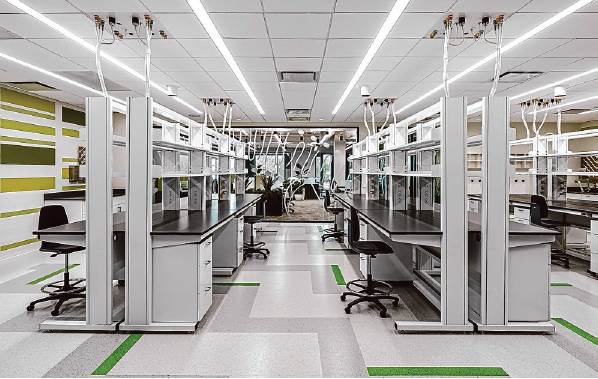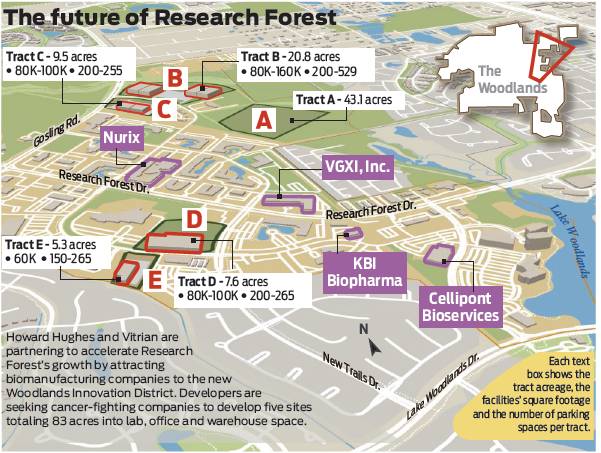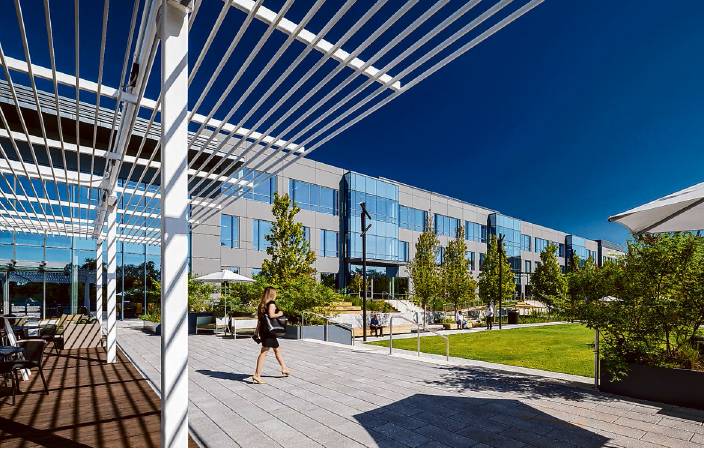Research hub in the forest
Woodlands seeks to attract biotech companies with new innovation district
By Claire Partain STAFF WRITER
The Woodlands aims to become a key cog in Houston’s cancer-fighting machine with more than 80 acres of future biotech development.
The new Woodlands Innovation District is a reimagining of what has been known as The Research Forest, which was first pitched as a future life sciences hub in the 1980s by founder George Mitchell.
Developer Howard Hughes is accelerating growth in the district through a partnership with Vitrian, which builds biomanufacturing facilities across the country.
“This is truly going to be what I’m calling the rebirth of Research Forest,” said Gil Staley, CEO of The Woodlands Area Economic Development Partnership. “This new innovation district is going to bring us assets that will carry us far into the future.”
How biomanufacturing works
Biomanufacturing uses living materials, including blood, animal cells or microorganisms, to produce medicines. Within that umbrella, cell therapy uses human cells to treat autoimmune diseases, spinal cord injuries and neurological disorders, among others.
One of its most common objectives, however, is treating cancer.
“These are personalized cures for late stage cancer,” Vitrian co-founder Scott Nudelman said.
Plans for development
Howard Hughes and Vitrian have tapped five potential sites totaling 83 acres for development. Each plot has the capacity to host at least one multinational company with multiple production lines, office space, manufacturing areas and warehouse space all under one roof, Nudelman said.
Approximately $400 million in biomanufacturing facility investments have been made in The Woodlands and Conroe area, Nudelman said. Facilities could range from 40,000 to more than 200,000 square feet per site. Total square footage could total 1 million square feet and host hundreds of jobs across income levels, Nudelman said.
“You can start with a high school diploma and a manufacturing certificate and earn $60,000 a year,” Nudelman said. “There aren’t that many industries with that level of education that you can have a true career out of.”
The Lone Star College-Montgomery campus in The Woodlands offers biotechnology associate degrees and laboratory technician certification. Soon, it will also offer specialized “tracks,” including biomanufacturing certification, for those beginning or continuing education.
“Our biotechnology program is one of the most sought after programs, not only because of how we train our students and get them prepared for the workforce, but also because of the relationships and partnerships that we have built in the industry,” Lone Star College-Montgomery president De’Reese Reid-Hart said.
Howard Hughes aims for the district to be completed in five to ten years.
“If we could do it next year, that would be great,” Howard Hughes’ Patrick Stites said. “We’re not going to hit the brakes for any of it.”
Attracting new companies
Although its name is relatively new, the mission behind The Woodlands Innovation District has been decades in the making, Staley said. The Woodlands began attracting more west coast companies through advertising campaigns during the pandemic, he said.
In nine years, the health care industry has grown from 18 to 30% of The Woodlands’ workforce as it diversified out of energy and brought in five major hospitals.
“Bringing all of those hospitals up here within the last decade has really launched a kind of heightened interest,” Stites said.
Lower costs, more housing options and a qualified workforce bring biomanufacturing labs to the Houston region, Nudelman said.
Texas also offers financial incentives. The Cancer Prevention and Research Institute of Texas approved $68.5 million in grants to Houston institutions alone in February.
And when the district is complete, companies will also save time and money by having other facilities nearby, Nudelman said.
“Cell therapy itself has got its own supply chain, and The Woodlands is one of the very few places in the country that will, by virtue of investments, already have that entire supply chain in one place,” Nudelman said.
Hub takes shape
The floodgates have opened since Cellipont, a cell therapy manufacturer, transformed the former office space into a new 76,000-square-foot headquarters in the nearby Research Forest Lakeside development in March.
“Once you start the chain reaction, you could start to see others tow in behind groups like Cellipont. That’s certainly happening now,” Stites said.
Fellow California biotech firm Bionova Scientific has also applied for a tax abatement for a $56.1 million renovation at a 100,000 square-foot facility in the area, according to the Montgomery County Commissioners Court agenda April 5.
A new $118 million life science hub anchored by cancer-fighting biopharmaceutical company Nurix is also in the works nearby. The hub is backed by Alexandria Real Estate, which aims to create a cluster of life sciences firms it hopes could become a smaller alternative to Texas Medical Center.
Nudelman said the two areas will continue to be vital to Houston’s fight against cancer.
“Houston is literally the hub for advanced therapies to treat cancer...(and) the two biggest hubs are The Woodlands and the (Texas) Medical Center,” Nudelman said. “There’s more advanced manufacturing for cell therapy going on in Houston than anywhere else.”
Catherine Dominguez contributed to this report.



